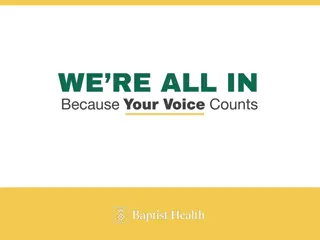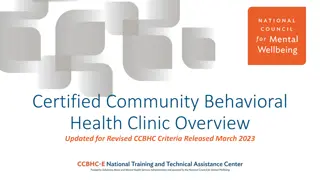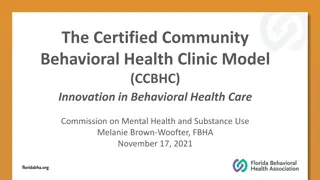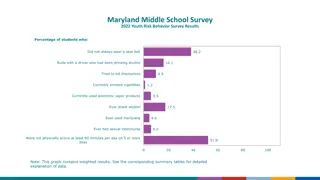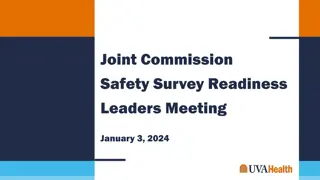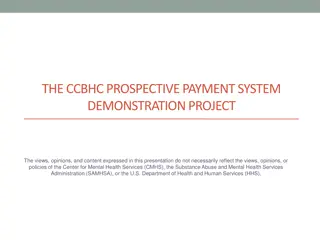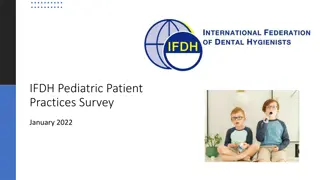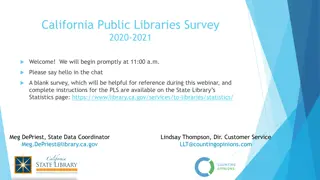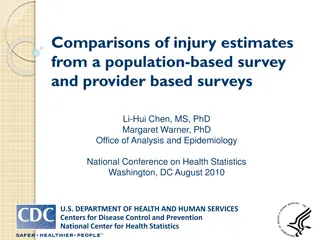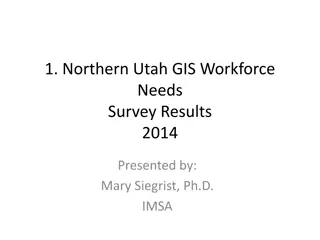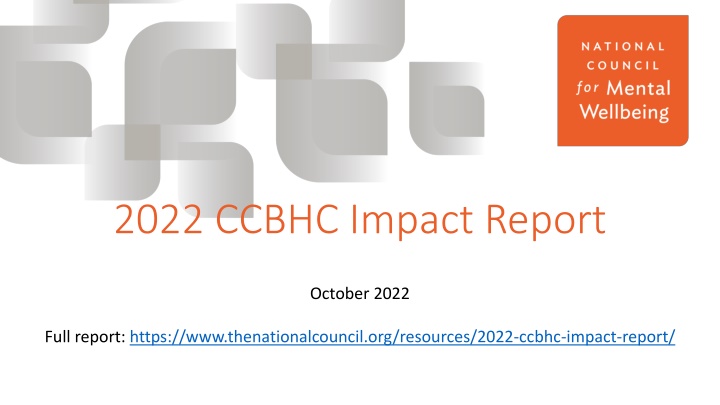
CCBHC Impact Report 2022: Key Findings and Insights
Explore the latest findings from the CCBHC Impact Report 2022, including respondent characteristics, caseload expansions, workforce insights, and types of staff hired. Discover how CCBHCs are improving mental health services nationwide.
Download Presentation

Please find below an Image/Link to download the presentation.
The content on the website is provided AS IS for your information and personal use only. It may not be sold, licensed, or shared on other websites without obtaining consent from the author. If you encounter any issues during the download, it is possible that the publisher has removed the file from their server.
You are allowed to download the files provided on this website for personal or commercial use, subject to the condition that they are used lawfully. All files are the property of their respective owners.
The content on the website is provided AS IS for your information and personal use only. It may not be sold, licensed, or shared on other websites without obtaining consent from the author.
E N D
Presentation Transcript
2022 CCBHC Impact Report October 2022 Full report: https://www.thenationalcouncil.org/resources/2022-ccbhc-impact-report/
About the National Councils CCBHC Impact Survey Conducted annually since 2017 Incorporated information about CCBHC grantees beginning in 2021 Most up-to-date snapshot of CCBHCs and grantees activities nationwide See Survey Method Statement at the end of this presentation
Respondent characteristics 249 of 450 CCBHCs responded to the survey, for a response rate of 55%. Response rates were roughly equivalent among grantees and state-certified sites but grantees and newer CCBHCs made up a larger proportion of respondents. Raw data were not weighted and are therefore only representative of the individuals who completed the survey. Definitions: State-certified clinics are those certified by their states under the demo, a SPA or a waiver, regardless of whether they also received a grant or not (N = 73). Grantee-only clinics are those that have received a SAMHSA CCBHC grant but are not certified by their states (N = 176) 57 respondents (23%) are located in rural areas 24 respondents (10%) are dually certified as FQHCs.
Caseload Expansions State-certified clinics had larger average caseload increases (30% average increase for state-certified sites vs. 18% for grantee-only sites).* *Difference is statistically significant
Employees and Vacancies These workforce expansions represent a 13% increase compared to prior to becoming a CCBHC. Grantee-only sites had a 10% increase in staff, and state-certified sites had a 16% increase in staff.* *Difference is statistically significant
Most Common Types of Staff Hired Which of the following types of staff has your organization hired, or is currently looking to hire, since becoming a CCBHC? Please select all that apply. Type of staff hired or looking to hire Percent* Peer support specialists or recovery specialists Data analysts or other staff focused on data reporting/management Primary care providers (e.g., physicians, nurses, MAs, etc.) Substance use disorder counselors Psychiatrists Community health workers Buprenorphine prescribers (i.e., DATA 2000 waivered clinicians) Psychologists Other 84% 79% 68% 67% 51% 50% 45% 16% 15% *Among respondents that indicated they hired staff as a result of becoming a CCBHC
Recruitment, Retention and Vacancy Rates Numerous respondents commented that their workforce challenges were overwhelmingly influenced by the pandemic, but that the positive effects of becoming a CCBHC helped offset some of the negative effects of the pandemic. Becoming a CCBHC allowed us to make significant salary increases and improve benefits to all staff. While COVID is very detrimental... I cannot imagine where we d be without having become a CCBHC. NorthCare (Oklahoma)
Recruitment, Retention and Vacancy Rates State-certified sites were more likely than grantee-only sites to report that since becoming a CCBHC they have had a better experience with recruitment, retention and vacancy rates.
Strategies to Mitigate the Workforce Shortage The most common strategy respondents are using to mitigate the effects of the workforce shortage is raising salaries or offering bonuses (92%). State-certified sites were more likely than grantee-only sites to report engaging in this strategy (97% vs. 89%).* Strategies to Mitigate the Effects of the Workforce Shortage All respondents Raising salaries and/or offering bonuses Engaging in staff wellbeing efforts, revamping employee benefits, or other strategies to improve staff satisfaction and retention Partnerships with clinician training programs (e.g., universities) Revising job descriptions and care teams to allow staff to practice at the top of their license Enhancing the provision of integrated behavioral health and primary care so more needs can be addressed in a single visit Serving as a National Health Service Corps (NHSC)-eligible site for loan repayment Participating in another kind of loan repayment program (not NHSC) Registered apprenticeships Other None 92% 86% 62% 59% 57% 46% 35% 14% 22% 1%
Themes from Respondent Comments Respondents frequently noted that becoming a CCBHC has been critical in filling staffing gaps and allowing CCBHCs to hire for non-clinical positions. Many commenters shared that staff enjoy working at a CCBHC more than other practice settings or industries, which is helping with staff retention. On the other hand, paperwork was frequently cited as a reason for burnout and staff turnover. We have several positions to fill, but once filled, we are retaining employees for longer periods of time. We are finally more competitive with other area behavioral health agencies/positions/schools. We've had an increased interest in practicums, so much so that we don't have room for all of the interested students! Central Kansas Mental Health Center
Number of Clients Engaged in Medication Assisted Treatment State-certified sites were more likely to say their number of clients on MAT has increased significantly (51% of state-certified respondents vs. 17% of grantee-only respondents)* *Difference is statistically significant
Expansion of Access to MAT 94% of CCBHCs and grantees directly provide medications for substance use disorder (SUD) treatment. Many respondents added access to these medications as a direct result of becoming a CCBHC.
MAT for Opioid Use Disorder (OUD) Among respondents who do not currently directly offer these medications, many make them available via referral and others intend to add them in the future.
Primary Care Partnerships & Referrals Most respondents (73%) deliver primary care screening and monitoring directly. How does your organization meet the primary care screening and monitoring requirements in the CCBHC criteria? Please select all that apply. FQHCs are the most common DCO partner for this service. % of all respondents 73% 32% Directly Through partnership with an FQHC as a DCO Through partnership with a different primary care provider as a DCO Provide services directly AND have a DCO Still working to meet this requirement 81% of respondents who track referrals to primary care partners report that their number of referrals to primary care has increased since becoming a CCBHC. 9% 17% 7% What is a DCO? A DCO is an organization that works with a CCBHC to deliver the full array of required services. CCBHCs and DCOs establish formal agreements ensuring delivery of care in alignment with the federal criteria. The DCO relationship represents an opportunity to align and integrate other community providers under the "umbrella" of the CCBHC model.
How has your organizations focus on clients physical health changed? As an agency we've always focused on monitoring our clients physical health. Becoming a CCBHC has enabled us to emphasize data and use it to track clinical outcomes. Genesee Health System (Michigan) We have trained staff to take blood pressures and monitor different areas related to physical health. Every client s treatment plan has a physical health goal. The Wellness Director, an RN, meets with every new employee to review how to screen and assist clients with their physical health needs. The Guidance Center (Pennsylvania)
Availability of Crisis Call Lines With their array of crisis response services and partnerships, CCBHCs are ideal partners in states efforts to strengthen their 988 and crisis response systems.
Availability of Mobile Crisis and Crisis Stabilization CCBHCs are expanding the availability of crisis care in their communities, both directly and through partnerships. Among CCBHCs that directly operate 24/7 crisis call line(s), mobile crisis response, or crisis stabilization, nearly half (49%) had to add new crisis services or partnerships as a result of CCBHC certification. State-certified sites were more likely than grantee- only sites to add mobile crisis (56% vs. 33%) and crisis stabilization (44% vs. 19%) services or partnerships as a result of certification.* *Difference is statistically significant
Partnerships with Hospitals & EDs Nearly all (98%) CCBHCs and grantees are also working to improve collaboration with local hospitals and/or emergency departments. While more than two-thirds of respondents (68%) have formal agreements in place with their hospital/ED partners, the near-universal adoption of these activities indicates that enhanced collaboration does not have to wait for establishment of a formal agreement.
Needs for Support Related to Crisis Care When thinking about your organization s ability to participate in or coordinate with local/state crisis systems (including efforts emerging from 988 implementation), which of the following types of support would be most helpful to you? All respondents 79% 64% 55% Securing additional financing to support hiring, technology, or other needs Staff training (e.g., training for crisis responders or clinic leadership, etc.) Stakeholder alignment (e.g., cross-sector workgroups, local/state/national level convenings, etc.) Building tools and staff capacity to leverage data Learning and/or sharing high-impact innovations Changing state laws or regulations to reduce barriers in accessing services Building a research base to adapt existing models/tools to meet the needs of specific groups or improve interventions Support with launching or strengthening direct service lines Other, please specify Nothing 53% 53% 46% 42% 37% 3% 1%
Child & Youth Services Most respondents (94%) directly deliver services to children and youth; others (8%) collaborate with a DCO for child/youth services.
Activities to Address Health Disparities *Percent is less than 1% but greater than 0%
Support Needed to Address Health Disparities Which of the following types of organizational support are most needed to advance your CCBHC s ability to address health disparities in your service area among people of color or other historically marginalized populations? All respondents 98% 67% 61% Any response below Securing additional financing to support hiring, technology, or other needs Building tools and staff capacity to leverage data (e.g., access to data to understand health disparities, support on what to do when looking at data that indicates health disparities, etc.) Staff training (e.g., training for clinicians or clinic leadership) Learning and/or sharing high-impact innovations Stakeholder alignment (e.g., cross-sector workgroups, local/state/national level convenings, etc.) Building a research base to adapt existing models/tools to meet the needs of specific groups or improve interventions Support with launching or strengthening direct service lines Changing state laws or regulations to reduce barriers in accessing services Other, please specify None 50% 47% 41% 39% 38% 37% 6% 2%
Questions? Rebecca Farley David Senior Advisor, Public Policy and Special Initiatives rebeccad@thenationalcouncil.org
Survey Method Statement The research was conducted online in the United States by The Harris Poll on behalf of the National Council for Mental Wellbeing among 249 certified community behavioral health clinics (CCBHCs and grantees). The survey was conducted July 14th August 26th, 2022. Raw data were not weighted and are therefore only representative of the individuals who completed the survey. Respondents for this survey were among the 449 total participating CCBHCs and grantees who were asked to participate of which 249 participated in our survey and are included in the final results. The sampling precision of Harris online polls is measured by using a Bayesian credible interval. For this study, the sample data is accurate to within + 6.2 percentage points using a 95% confidence level. This credible interval will be wider among subsets of the surveyed population of interest. All sample surveys and polls are subject to other multiple sources of error which are most often not possible to quantify or estimate, including, but not limited to coverage error, error associated with nonresponse, error associated with question wording and response options, and post-survey weighting and adjustments.

